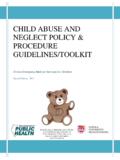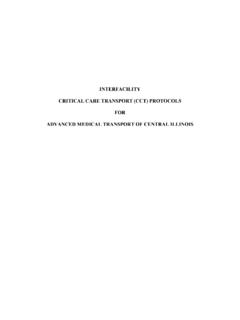Transcription of Tranexamic Acid Protocol - paems.org
1 PEORIA area EMS system PREHOSPITAL CARE MANUAL 216 Tranexamic Acid (TXA) is a synthetic amino acid (lysine) that blocks plasminogen from being converted to the enzyme plasmin. Plasmin works to break down already-formed blood clots in the human body by attacking and breaking down fibrin destroying clots in a process known as fibrinolysis. TXA is now being used to treat severely injured trauma patients who have or are at risk for severe hemorrhage. Indications: Any trauma patient 14 years of age, at high risk for ongoing internal hemorrhage and meeting one or more of the following criteria: Systolic BP < 90mmHg Patients 65 years of age with systolic BP < 110mmHg. Tachycardia > 120 beats per minute with signs of hypoperfusion (confusion, altered mental status, cool extremities, etc.) Contraindications: Injuries > 3 hours old. Evidence of Disseminated Intravascular Coagulation (DIC) Patients < 14 years of age. Hypersensitivity to the drug. 1. How Supplied: 10mL vial containing 1000mg 2.
2 Preparation: Mix 1000mg of TXA in 250 mL of Normal Saline. 3. Administration: Infuse over 10 minutes 10 gtts/mL tubing at a drip rate of 4 gtts/second. Infusion pump (if available) at 1500mL/hr. 4. Notify receiving hospital of TXA administration. 5. Clearly document mechanism of injury, time injury/incident occurred, indications for use and time TXA was administered. Tranexamic Acid Protocol ALS ONLY PEORIA area EMS system PREHOSPITAL CARE MANUAL 217 Critical Thinking Elements TXA should never be administered at a wide open rate Female patients taking or using any form of birth control containing estrogen and progestin are at increased risk for blood clots and this medication significantly increases that risk. Hypotension has been observed when TXA is administered too rapidly. Use with caution in patients with a history of DVT, PE, known clotting disorders or severe renal failure In patients with DIC, blood clots form throughout the body's small blood vessels reducing or blocking blood flow which may cause a variety of signs/symptoms: Brain: Signs of stroke such as speech and movement problems Legs: Swelling, redness and warmth Lungs: Shortness of breath Heart: Chest pain or Myocardial Infarction Skin: Petechiae (red spots on the skin that appear like a series of tiny bruises) Tranexamic Acid Protocol ALS ONLY


